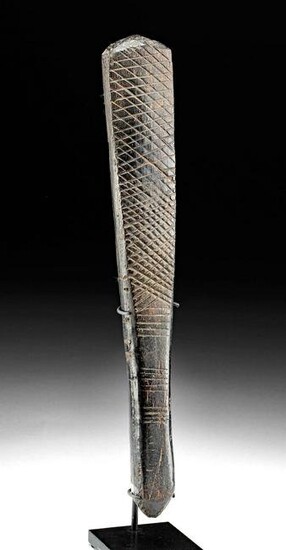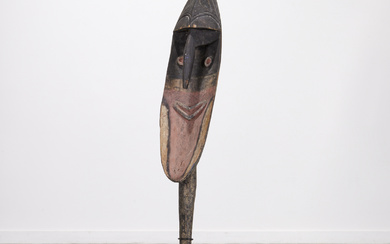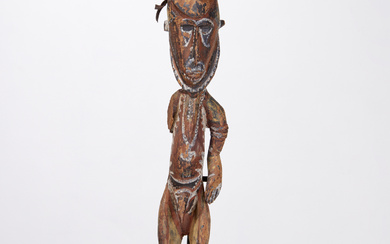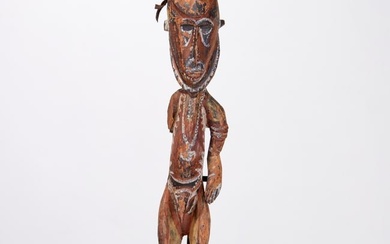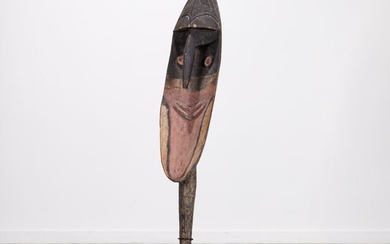20th C. Papua New Guinea Wood Tapa Beater
Oceanic, Papua New Guinea, ca. early to mid-20th century CE. An impressive one-sided tapa cloth beater, skillfully hand-carved from espresso-hued hardwood to present a flattened, elliptical form. The beater head exhibits a rounded verso and flat face incised with a dense cross-hatched pattern in order to pulverize the inner bark of Mulberry trees into the soft and pliable strands that are used to make tapa cloths. The broad head tapers to a smoothed, pointed handle, also with a rounded-off backside. When laid flat on its backside, the beater is reminiscent of traditional fishing boats often seen in Papua New Guinea. Size: 1.8" W x 13.3" H (4.6 cm x 33.8 cm); 14.5" H (36.8 cm) on included custom stand.
Tapa cloths are traditionally made by beating the inner bark of mulberry or similar trees until it is soft and pliable, and then painted using a palette of naturally occurring pigments. They can be found in the South Pacific Islands, mainly Tonga, Samoa, and Fiji, but also as far afield as Hawaii and New Zealand. Tapa was introduced to the western world in the late 18th century by Captain Cook's first expedition, where it was collected under the direction of Joseph Banks and brought to Europe. In Polynesian society, the cloth is of great social importance and is often given as a gift; however, prior to the introduction of synthetic fabrics, it was also used for everyday wear. Today it is worn only at special occasions such as weddings.
Provenance: private Hawaii, USA collection, acquired from 1995 to 2010
All items legal to buy/sell under U.S. Statute covering cultural patrimony Code 2600, CHAPTER 14, and are guaranteed to be as described or your money back.
A Certificate of Authenticity will accompany all winning bids.
PLEASE NOTE: Due to recent increases of shipments being seized by Australian & German customs (even for items with pre-UNESCO provenance), we will no longer ship most antiquities and ancient Chinese art to Australia & Germany. For categories of items that are acceptable to ship to Australia or Germany, please contact us directly or work with your local customs brokerage firm.
Display stands not described as included/custom in the item description are for photography purposes only and will not be included with the item upon shipping.
#168542
Condition Report: Expected nicks, chips, and abrasions, as well as some minor areas of loss, all commensurate with age and use. Otherwise, excellent with rich patina.
View it on
Estimate
Time, Location
Auction House
Oceanic, Papua New Guinea, ca. early to mid-20th century CE. An impressive one-sided tapa cloth beater, skillfully hand-carved from espresso-hued hardwood to present a flattened, elliptical form. The beater head exhibits a rounded verso and flat face incised with a dense cross-hatched pattern in order to pulverize the inner bark of Mulberry trees into the soft and pliable strands that are used to make tapa cloths. The broad head tapers to a smoothed, pointed handle, also with a rounded-off backside. When laid flat on its backside, the beater is reminiscent of traditional fishing boats often seen in Papua New Guinea. Size: 1.8" W x 13.3" H (4.6 cm x 33.8 cm); 14.5" H (36.8 cm) on included custom stand.
Tapa cloths are traditionally made by beating the inner bark of mulberry or similar trees until it is soft and pliable, and then painted using a palette of naturally occurring pigments. They can be found in the South Pacific Islands, mainly Tonga, Samoa, and Fiji, but also as far afield as Hawaii and New Zealand. Tapa was introduced to the western world in the late 18th century by Captain Cook's first expedition, where it was collected under the direction of Joseph Banks and brought to Europe. In Polynesian society, the cloth is of great social importance and is often given as a gift; however, prior to the introduction of synthetic fabrics, it was also used for everyday wear. Today it is worn only at special occasions such as weddings.
Provenance: private Hawaii, USA collection, acquired from 1995 to 2010
All items legal to buy/sell under U.S. Statute covering cultural patrimony Code 2600, CHAPTER 14, and are guaranteed to be as described or your money back.
A Certificate of Authenticity will accompany all winning bids.
PLEASE NOTE: Due to recent increases of shipments being seized by Australian & German customs (even for items with pre-UNESCO provenance), we will no longer ship most antiquities and ancient Chinese art to Australia & Germany. For categories of items that are acceptable to ship to Australia or Germany, please contact us directly or work with your local customs brokerage firm.
Display stands not described as included/custom in the item description are for photography purposes only and will not be included with the item upon shipping.
#168542
Condition Report: Expected nicks, chips, and abrasions, as well as some minor areas of loss, all commensurate with age and use. Otherwise, excellent with rich patina.
